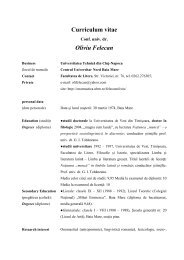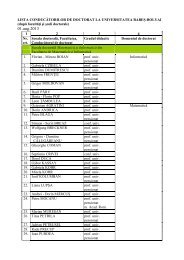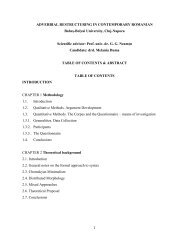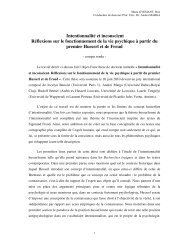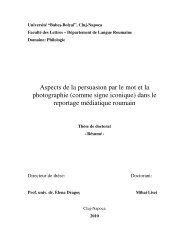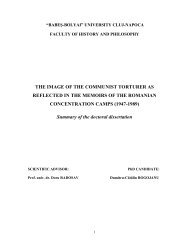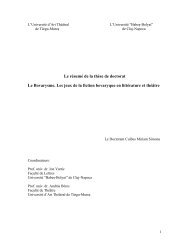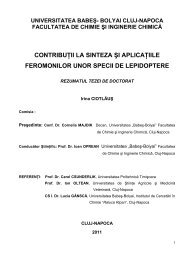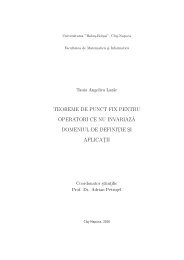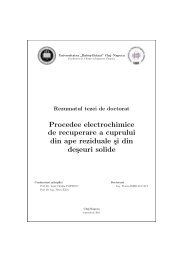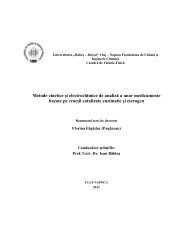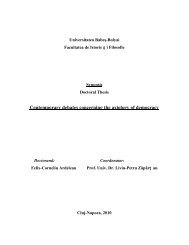CONTRIBUTION TO CINCHONA ALKALOIDS CHEMISTRY
CONTRIBUTION TO CINCHONA ALKALOIDS CHEMISTRY
CONTRIBUTION TO CINCHONA ALKALOIDS CHEMISTRY
You also want an ePaper? Increase the reach of your titles
YUMPU automatically turns print PDFs into web optimized ePapers that Google loves.
Ph.D. Thesis Abstract Contribution to cinchona alkaloids chemistry<br />
1. INTRODUCERE<br />
.<br />
Cinchona alkaloids are the most important compound class, being isolated from the<br />
Cinchona and Rubiaceous genera tree. They are organic molecules with an interesting<br />
history. They have been used from the early seventeenth century, when they were first<br />
introduced in Europe after the discovery of the antimalarial properties<br />
of Cinchona tree bark extract and the isolation of active principles by<br />
PJ Pelletier and J.B.Caventou in 1820 [13.14]. About 30 compounds are extracted from the bark<br />
of trees. Alkaloid content of the crust ranges from 5 to 16%. The main components of the<br />
extract are quinine 1 (60-85%), quinidine 2, cinconine 3 and cinconidine 4. For over 300<br />
years cinchona alkaloids have played an important role in medicine and more recently in organic<br />
synthesis.<br />
11<br />
10<br />
OCH3<br />
6`<br />
2<br />
7<br />
8<br />
N<br />
1<br />
4`<br />
9<br />
OH<br />
H<br />
N<br />
1`<br />
2`<br />
3`<br />
3<br />
4<br />
6<br />
5<br />
OCH3<br />
6`<br />
N<br />
1`<br />
2`<br />
11<br />
10<br />
OH 2<br />
7<br />
4` 9<br />
8<br />
N<br />
H 1<br />
3`<br />
3<br />
4<br />
6<br />
5<br />
N<br />
1`<br />
2`<br />
3<br />
6`<br />
11<br />
10<br />
OH 2<br />
7<br />
4` 9<br />
8<br />
N<br />
H 1<br />
3`<br />
3<br />
4<br />
6<br />
5<br />
N<br />
1`<br />
2`<br />
2<br />
7<br />
8<br />
N<br />
1<br />
4`<br />
9<br />
OH<br />
H<br />
Chinina 1 Chinidina 2 Cinconina 3 Cinconidina 4<br />
Figura.1.1. Structure of cinchona akaloids<br />
Cinchona alkaloids are structurally composed of a quinoline ring and linked to a bulky<br />
heterocycle, chinuclidinic, connected through a carbon atom to a C9 OH group (Figure1.1). This<br />
is one of the four chiral centers of the molecule. Only C8 and C9 can have different<br />
configurations. C8 and C9 chiral centers are S and R in quinine, quinidine, respectively both R<br />
and S isomers being eritro. The epimers of these compounds are 8S and 9S for epiquinine<br />
respectively 8R and 9R for epiquinidine, these compounds are threo isomers [22].<br />
Hoffmann and co. were able to split the cinchona alkaloids in pure enantiomer quinoine<br />
derivates, 1-azabiciclo [2.2.2] octane. This was achieved trough the oxidation reaction while<br />
simultaneously reducing exposure to air. The reaction takes place in ether or tetrahydrofuran [33].<br />
During investigations they have tested various reducing agents, the best results<br />
were obtained when using lithium aluminumhydride. The fact that this reaction takes place only<br />
6`<br />
3`<br />
11<br />
10<br />
3<br />
4<br />
6<br />
5



